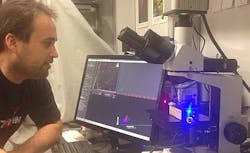Nanoparticle tracking analysis shows promise for cancer metastasis research
Researchers at Weill Cornell Medical College (New York, NY) used nanoparticle tracking analysis (NTA) to better understand and characterize exosomes, which are nanoparticles that secrete from tumor cells. The workâled by Hector Peinado Selgas, Ph.D., and David Lyden, Ph.D., MDâcould help to shed insight on how cancer spreads, known as metastasis.
The researchers used NTA (the LM-10 system from NanoSight; Salisbury, England), which uses a laser light source to illuminate nano-scale particles, to discover how exosomes secreted from melanoma tumor cells are educating bone marrow-derived progenitor cells toward a pro-metastatic phenotype, explains Peinado. Their group is also interested in analyzing the use of exosomes as biomarkers of specific tumor types and their use as prognostic factors, he adds. Cornell University currently has pending patents on this technology.
Using NTA, the group found that the protein content per exosome is increased in metastatic melanoma patients. "In addition, we have observed that metastatic cell lines also have increased protein content per exosome. Therefore, knowing the number of exosomes was a definitive and necessary step in our reseach. Before this work, we were only following qualitative changes in exosomes," Peinado continues.
NTA technology enabled the researchers to analyze millions of particles, particle by particle, in minutes, giving numbers and population distribution, Peinado explains. Although measurement of the size of the particles is not as accurate as electron microscopy, NTA enabled them to process a large number of samples in a short time period, he says.
The group's work has been published in Nature Medicine; for more information, please visit http://www.nature.com/nm/journal/v18/n6/full/nm.2753.html.
-----
Follow us on Twitter, 'like' us on Facebook, and join our group on LinkedIn
Laser Focus World has gone mobile: Get all of the mobile-friendly options here.
Subscribe now to BioOptics World magazine; it's free!

